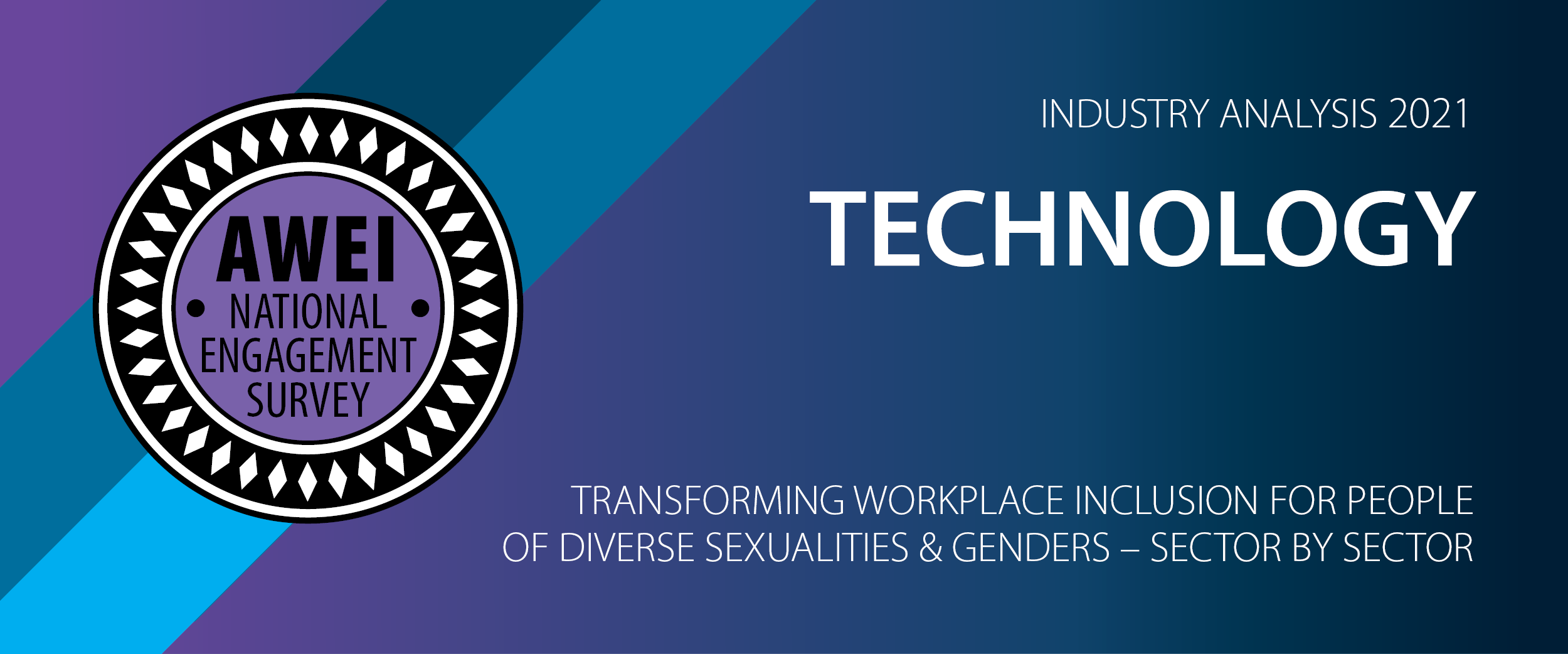
The Australian Workplace Equality Index National Engagement Survey 2021: Technology Sector Observations
written by Mark Latchford, Associate Director, Pride in Diversity |15 June 2021
The 2021 engagement survey saw a significant increase in participants from the Technology sector, with over 2,800 survey respondents from organisations with the sector. (The analysis does not include those technology professionals employed in other sectors). Of these, 326 participants identified as being part of the LGBTQ community.
In regard to the demographic segmentation, the sector differs from the national mix in a number of significant areas:
- The sector is more centralized into NSW (54% compared to 30% of the national cohort)
- Has more employees with bachelor degrees (44% vs 32%)
- Has more men than women (55% vs 43% whereas the national mix is 43% 54%)
- The sector also appears to be under-represented by Aboriginal and/or Torres Strait Islanders, people living with disabilities and mature age employees. It has a higher representation of people of colour and those who have a CALD background.
When you look at the state of LGBTQ workplace inclusion, the survey indicators that the technology sector is performing better than most. In nearly all the key questions within the survey, the sector records better performance than the national results.
Some of the most pronounced differences include:
- 70% of respondents in the sector thought an organisation positive track record in this aspect of inclusion would positively influence me to join the organisation. (59% nationally)
- 86% thought that Initiatives in this sea have been regularly communicated during the year (n: 75%)
- 74% stated that awareness or ally training was made available throughout the year (n:59%) and 54% had attended such training (n:35%)
- 69% claimed jokes and innuendo were called out and addressed (n:57%)
- 10% witnessed of negative behaviours/mild harassment which was 14% nationally.
Business case indicators were also more positive with 90% of the professionals feeling productive at work (n:88%) and 86% feel engaged (n:81%). Health and wellbeing indicators are also higher than average.
In regard to Allies, the sector matches the national profile, except when asked why not an active ally, being too busy is cited 50% of the time (versus 42% by the national cohort)
Communication about inclusion as it relates to sexuality and gender diverse employees is markedly better in the technology sector, across all areas but especially in the recruitment process (72% vs 53%)
Executive endorsement is also significantly better (86% vs 67%) as is network promotion (86% vs 68%), training promotion (75% to 57%). It is particularly pleasing to see 81% felt managers would address negative commentary and jokes (n: 66%) and active allies are visible to 75% of the cohort (n: 57%)
Willingness to recommend the organisation and absence of inappropriate jokes/innuendo is also significant better that national data. 67% felt that active allies had had a positive impact (n:49%)
In regard to the LGBTQ cohort of respondents, 45% being out to everyone was higher than the national 40%, which may reflect the communication vehicles used within the industry.
The sector is also strong in supporting employees coming out to external stakeholders (such as clients). 92% felt support (n: 78%). Sexuality was not having an impact on their career progression 92% vs 81%).
Only 7% had been the target of unwanted jokes and innuendo which is nearly half the national rate of 13%. Being the target of more serious bullying and sexual harassment was again half the national rate 3% as opposed to 6%.
One of the most significant variation from the national indicators was whether workplace inclusion initiatives (for diversity of sexuality and gender) have had a positive impact on how they felt about their sexuality. 84% agreed on this point, whereas nationally only 60% did.
In regard to not being out, the overall percentage is lower as mentioned. The reasons why tend to be similar but lower than the national data except for “not comfortable within myself to be out at work”. That was cited as the reason by 44% of this sector, but only 37% nationally.
On the question relating to women, the numbers again tended to be significantly better except for one: “Women of similar identity as me are out within senior leadership” , 32% agreed with that versus 39% nationally.
On gender diverse recruiting, the data indicates this sector has progressed well. For example, 49% of respondents found the recruitment process inclusive for diverse gender applicants (n:34%)
Moreover, freedom to use toilets of choice (58% vs n:42%) and availability of all gender toilets (36% vs 28%) was more positive in this sector. Acknowledgement of gender diversity beyond the binary was at 70% (as opposed to 47% nationally. Folk making an effort to use personal pronouns was relatively high (42% vs n: 27%) and being misgendered was below the national average. In nearly all other aspects of gender diversity inclusion, the sector is positively well ahead (double digit differences) from the general national experiences. This includes 2% being the target of serious bullying and harassment for their gender diversity (nationally it is 6%). However, 8% of this sector (and the national cohort) had been the targets of unwanted jokes, innuendo and commentary.
As previously mentioned, in regard to intersectionality, the sector appears to have achieved results where colour/CALD and neurodiversity intersect with the LGBTQ community, but more work is needed with those of Aboriginal and Torres Strait Islander heritage or those of a mature age.
In summary, the Technology Sector can be proud of their substantive work in this space. Their teams indicate through the survey, that much progress has been made. The data confirms the journey is not done and a number of areas are requiring specific and focused work (confirmed by benchmark results in participating technology firms).

